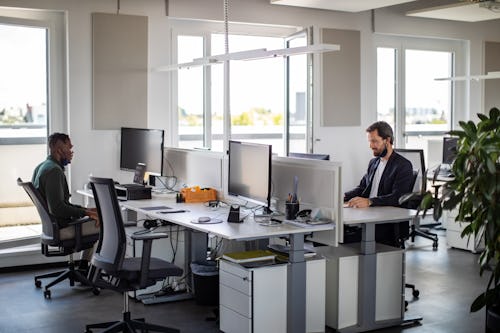
Wear a mask. Practice social distancing. Get vaccinated. At this point, we’ve come to accept these recommendations as pandemic gospel. Follow them, and we’ll free ourselves from COVID’s hellacious grip. But what if we could curb transmission at a more systemic level, beyond individual actions? Research points to a solution that’s been in front of us all along: fresh air. Some scientists believe that regulating the airflow through our buildings could play a major role in helping us get a handle on the pandemic.
First, though, a refresher on how COVID spreads: Back in the early days of the panny, the CDC stated that exposure to large droplets from talking, sneezing, and coughing was the main source of transmission, explains John Zhai, a professor of building systems engineering at the University of Colorado Boulder. These larger droplets quickly fall onto surfaces, which is why the agency recommended mask wearing and the six-foot social distancing rule.
But last June, Zhai and 200 other scientists from around the world signed a letter calling for the medical community to acknowledge the risk of airborne transmission of SARS-CoV-2, the virus that causes COVID-19. They outlined evidence that smaller virus-laden droplets can stay aloft much longer and travel greater distances than the larger droplets that we were more familiar with. A droplet measuring five microns — about the size of a human red blood cell — could flow tens of meters indoors, “much greater than the scale of a typical room,” according to the letter.
“Concentration matters,” though, Zhai tells Mic. In other words, one or two virus-filled droplets floating around in a room probably won’t get you sick. “We need a certain amount of virus to trigger infection.” Diluting the concentration of virus in the air, then, could prevent infection.
How do we do that? By supplying indoor spaces with outdoor air —which we assume is clean, Zhai says. Although the CDC asserts that less than 10% of infections occurred outdoors, he and other experts believe this is an overestimate, since the agency also counts festivals and other crowded outdoor activities beyond the more typical walk or bike ride in its calculations.
Diluting the concentration of virus in the air could prevent infection.
But heating, ventilation, and air conditioning (HVAC) systems are designed primarily for heating and cooling — which uses way less outdoor air than needed to dilute the viral concentration to low enough levels, Zhai says. Since filling residential buildings with fresh air is simply a matter of opening a door or window, they don’t even have ventilation standards.
The American Society of Heating, Refrigerating and Air-Conditioning Engineers (ASHRAE) does set ventilation standards for commercial buildings, though, Zhai says. (He explains that these standards just describe best practices — it’s up to states and counties to decide whether to enforce them.)
In general, the air in most commercial buildings should be fully replaced once every hour. But Zhai notes that this air change rate per hour was set pre-pandemic, and needs to be increased if we want to sufficiently lower the concentration of the virus. Some organizations have recommended bumping it up to four or five ACH.
Zhai believes that the more restaurants, gyms, schools, and other commercial buildings do what they can to better ventilate their spaces, the more we can change the course of the pandemic for the better. He and his colleagues have found that in large public spaces, the risk of infection rises with time spent inside — but falls with increased ACH (although this research hasn’t been published yet). Better ventilation could fill in the gaps created by schools that, say, require masks, but not necessarily social distancing.

But some remain skeptical about the role small droplets that remain airborne for long periods of time actually play in transmission. “The extent to which it can spread by small aerosols, I think, is still not fully clarified,” Nasia Safdar, medical director of infection control at UW Health, tells Mic.
Plus, increasing the ACH isn't as simple as it sounds, which might also help explain why it’s been eclipsed by more straightforward precautions like mask wearing. “Manipulating HVAC systems is a considerable investment of resources and often cannot be done, practically speaking, depending on the age and size of the building,” Safdar points out.
In most buildings, the fan and duct sizes are too small to deliver that much fresh air, Zhai says. To pump in enough fresh air to dilute the concentration of SARS-CoV-2, business owners would need to sink a ton of money into not only initial costs like buying a bigger fan, he explains, but also operating costs — such a system would consume huge amounts of energy.
On the other hand, commercial buildings could work with what they have and take a cue from hospitals, which already redirect the air supply from different parts of their buildings to create additional quarantine wings, for example, Zhai says. Commercial buildings could route a duct from one floor to another, doubling the fresh air supply, and people would occupy only the floor with the combined air. Mechanical system manufacturers are investigating the possibilities of dynamic operation, Zhai adds, so that the air system runs only when it detects people in the space.
High-performance portable air filters that we use to remove pollen and dust can also remove potentially virus-carrying respiratory droplets, large and small, according to Zhai. Recently, he recommended that Marriot International buy a bunch of them to place in ballrooms for events, and in the lobbies and other public spaces the rest of the time.
A good rule of thumb: The higher the CFM and MERV number, the better. CFM, short for cubic feet per minute, refers to the amount of clean air the filter delivers to the space, while the MERV, or Minimum Efficiency Reporting Value, is the fraction of particles it removes from the air. Zhai says that filters with a MERV of at least 13 — which can trap airborne viruses, according to ASHRAE — is recommended for most commercial buildings. But the higher the MERV, the denser the filter, and the bigger the fan needed to push the air across it. Since bigger fans are also noisier, business owners might need to find a happy medium between protecting and annoying building occupants.
As promising as these clever workarounds are, though, it’s important to consider them as part of a larger strategy. “I think it just needs to tied into the whole other suite of solutions rather than a standalone thing,” Safdar says. “It should be done if it seems to meaningfully impact transmission” — but if other measures reduce it just as well, then we need to emphasize them, too. And just maybe, collectively, they’ll allow us to breathe as easily as we used to.







